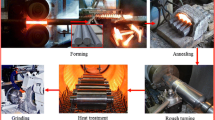Abstract
The present study reports the effect of different process parameters on machining forces, surface roughness, dimensional deviation and material removal rate during hard turning of EN31, SAE8620 and EN9 tool steels. Feed rate followed by hardness, cutting speed and nose radius-depth of cut significantly affected machining forces whereas feed rate had the largest effect on surface roughness. The four responses were subsequently optimized for both rough and finish machining using genetic algorithm to determine the optimum combination of input parameters. Machined surfaces were subsequently analyzed using XRD followed by analysis of grain size and crystallite size of the machined samples and SEM analysis. Higher chromium content was observed at the machined surface as manganese dissolves in cementite and may replace iron atoms in the cementite lattice after machining. High heat is generated when machining at higher cutting speeds causing severe strain. The depth of the white layer decreases with increasing tool nose radius and increases at larger feeds because of greater heat generation. The SEM observations showed a smooth pattern with very low undulations with almost no crack damage.
Similar content being viewed by others
References
http://www.hardinge.com/usr/pdf/hardturn/ASME.pdf accessed on 20th November (2010).
V. N. Gaitonde, S. R. Karnik, L. Figueira and J. P. Davim, Analysis of machinability during hard turning of cold work tool steel (type: AISI D2), Materials and Manufacturing Processes, 24(12) (2009) 1373–1382.
D. Singh and P. V. Rao, A surface roughness prediction model for hard turning process, International Journal of Advanced Manufacturing Technology, 32 (2007) 1115–1124.
D. Singh and P. V. Rao, Optimization of tool geometry and cutting parameters for hard turning, Materials and Manufacturing Processes, 22(1) (2007) 15–21.
S. Z. Chavoshi and M. Tajdari, Surface roughness modelling in hard turning operation of AISI 4140 using CBN cutting tool, International Journal of Material Forming, 3(4) (2010) 233–239.
J. Y. Zhang and S. Y. Liang, Process optimization of finish turning of hardened steels, Materials and Manufacturing Processes, 22(1) (2007) 107–113.
T. Ozel, T. K. Hsu and E. Zeren, Effects of cutting edge geometry, workpiece hardness, feed rate and cutting speed on surface roughness and forces in finish turning of hardened AISI H13 steel, International Journal of Advanced Manufacturing Technology, 25 (2005) 262–269.
L. Qian and M. R. Hossan, Effect on cutting force in turning hardened tool steels with cubic boron nitride inserts, Journal of Materials Processing Technology, 191 (2007) 274–278.
B. Sieben, T. Wagner and D. Biermann, Empirical modeling of hard turning of AISI 6150 steel using design and analysis of computer experiments, Production Engineering Research Development, 4 (2010) 115–125.
D. Lalwani, N. K. Mehta and P. K. Jain, Experimental investigations of cutting parameters influence on cutting forces and surface roughness in finish hard turning of MDN250 steel, Journal of materials processing technology, 206 (2008) 167–179.
M. A. Yallese, K. Chaoui, N. Zeghib, L. Boulanouar and J. F. Rigal, Hard machining of hardened bearing steel using cubic boron nitride tool, Journal of Materials Processing Technology, 209 (2009) 1092–1104.
S. Thamizhmanii, K. Kamarudin, K. Badrul, A. Saparudin and S. Hassan, Study of surface roughness on induction hardened steel using CBN cutting tool, In Proceedings of International Conference on Mechanical & Manufacturing Engineering, Johor Bahru, Malaysia (2008) ISBN: 97-98-2963-59-2.
M. A. Yallese, J. F. Rigal, K. Chaoui and L. Boulanour, The effects of cutting conditions on mixed ceramic and cubic boron nitride tool wear and on surface roughness during machining of X200Cr12 steel (60 HRC), Proceedings of the Institution of Mechanical Engineers, Part B: Journal of Engineering, 219(1) (2005) 35–55.
B. Pytlak, Multicriteria optimization of hard turning operation of the hardened 18HGT steel, International Journal Advance Manufacturing Technology, 49 (2010) 305–312.
P. J. Ross, Taguchi technique for quality engineering, 2ndedn. McGraw Hill, New York (1995).
D. E. Goldberg, Genetic Algorithm in search, Optimization and Machine Learning, Pearson Education Asia, New Delhi (2003).
M. Affenzeller, S. Winkler, S. Wagner and A. Beham, Genetic Algorithms and Genetic Programming, CRC Press, New York (2009).
Math Works inc. http://www.mathworks.com/
Y. Lakhtin, Engineering physical metallurgy and heattreatment, 4th printing, Mir Publishers, Moscow (1990).
Author information
Authors and Affiliations
Corresponding author
Additional information
Recommended by Associate Editor Jihong Hwang
Ajay Batish is Ph.D. in Engineering and presently working as Professor and Head Mechanical Engineering Department at Thapar University Patiala, India. He has almost 9 years industry and 14 years of teaching and research experience. He has published many research papers in international and national journals of repute.
Anirban Bhattacharya graduated in Mechanical Engineering and earned his Masters degree in Manufacturing Technology. Presently he is working as Assistant Professor in Mechanical Engineering Department at Thapar University Patiala, India. He has almost ten years of teaching experience and has published many research papers in international and national journals.
Rights and permissions
About this article
Cite this article
Batish, A., Bhattacharya, A., Kaur, M. et al. Hard turning: Parametric optimization using genetic algorithm for rough/finish machining and study of surface morphology. J Mech Sci Technol 28, 1629–1640 (2014). https://doi.org/10.1007/s12206-014-0308-y
Received:
Revised:
Accepted:
Published:
Issue Date:
DOI: https://doi.org/10.1007/s12206-014-0308-y




